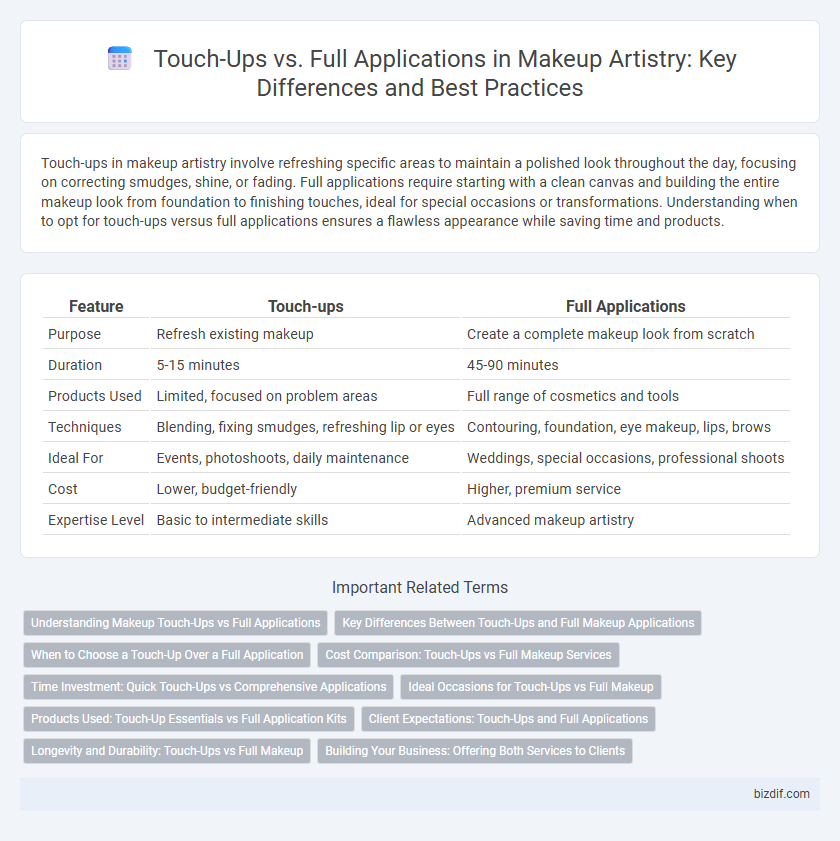Touch-ups in makeup artistry involve refreshing specific areas to maintain a polished look throughout the day, focusing on correcting smudges, shine, or fading. Full applications require starting with a clean canvas and building the entire makeup look from foundation to finishing touches, ideal for special occasions or transformations. Understanding when to opt for touch-ups versus full applications ensures a flawless appearance while saving time and products.
Table of Comparison
| Feature | Touch-ups | Full Applications |
|---|---|---|
| Purpose | Refresh existing makeup | Create a complete makeup look from scratch |
| Duration | 5-15 minutes | 45-90 minutes |
| Products Used | Limited, focused on problem areas | Full range of cosmetics and tools |
| Techniques | Blending, fixing smudges, refreshing lip or eyes | Contouring, foundation, eye makeup, lips, brows |
| Ideal For | Events, photoshoots, daily maintenance | Weddings, special occasions, professional shoots |
| Cost | Lower, budget-friendly | Higher, premium service |
| Expertise Level | Basic to intermediate skills | Advanced makeup artistry |
Understanding Makeup Touch-Ups vs Full Applications
Makeup touch-ups involve quick fixes to refresh or correct existing makeup, targeting areas prone to smudging or fading, such as lip color or under-eye concealer. Full applications require a complete makeup process, including skin preparation, foundation layering, contouring, and detailed eye makeup, designed to create a flawless and lasting look. Understanding the difference helps makeup artists optimize time and product use based on the client's needs and event duration.
Key Differences Between Touch-Ups and Full Makeup Applications
Touch-ups involve refreshing makeup to maintain appearance by addressing smudges, shine, or fading, typically requiring minimal products and time. Full makeup applications encompass the complete process of creating a base, contouring, eye makeup, and lip color, designed for long-lasting wear and significant transformation. Key differences include the scope, duration, and product usage, where touch-ups optimize existing makeup, and full applications build a comprehensive look from scratch.
When to Choose a Touch-Up Over a Full Application
Touch-ups are ideal for refreshing makeup during events when the base is intact but requires minor corrections such as blotting shine, reapplying lipstick, or fixing smudges. Choose touch-ups over full applications for quick fixes that maintain the original look without the time and products needed for a complete redo. Full applications are necessary when the makeup has worn off significantly, needs a new style, or requires comprehensive correction due to smudging, fading, or changes in lighting.
Cost Comparison: Touch-Ups vs Full Makeup Services
Touch-ups typically cost significantly less than full makeup applications, with prices often ranging from $30 to $70 compared to $100 to $200 for complete services. The lower cost of touch-ups reflects the shorter time required and the limited scope of products used, focusing mainly on refreshing and fixing existing makeup. Clients seeking cost-effective solutions for maintaining appearance throughout events often prefer touch-ups due to their affordability and convenience.
Time Investment: Quick Touch-Ups vs Comprehensive Applications
Quick touch-ups in makeup artistry typically require 5 to 15 minutes, making them ideal for refreshing the look by addressing minor flaws such as smudged eyeliner or faded lipstick. Comprehensive full applications usually demand 45 to 90 minutes, involving detailed processes like skincare preparation, contouring, coloring, and setting to achieve a polished and long-lasting finish. The time investment significantly impacts scheduling, with touch-ups suiting last-minute needs and full applications being essential for events requiring flawless, camera-ready makeup.
Ideal Occasions for Touch-Ups vs Full Makeup
Touch-ups are ideal for short events or when makeup needs refreshing during the day, such as meetings, casual outings, or before evening plans. Full makeup applications suit significant occasions like weddings, photo shoots, or formal events where a flawless, long-lasting look is essential. Both approaches cater to different needs, ensuring makeup remains fresh and appropriate for the setting.
Products Used: Touch-Up Essentials vs Full Application Kits
Touch-up essentials typically include compact powders, blotting papers, mini lipsticks, and travel-sized setting sprays designed for quick fixes throughout the day. Full application kits feature comprehensive products such as foundations, primers, contour palettes, eyeshadow sets, and a wider array of brushes to achieve a complete, professional look. Choosing touch-up products emphasizes portability and convenience, whereas full kits prioritize versatility and coverage for diverse makeup styles.
Client Expectations: Touch-Ups and Full Applications
Touch-ups address minor fixes and freshening of makeup throughout the day, ensuring the client maintains a polished look without undergoing a complete reapplication. Full applications involve a comprehensive process from cleansing and priming to contouring and setting, designed to create a flawless, long-lasting finish tailored to the event or client's preference. Understanding the distinction helps makeup artists manage client expectations effectively, ensuring satisfaction with either quick enhancements or elaborate glam.
Longevity and Durability: Touch-Ups vs Full Makeup
Full makeup applications offer superior longevity and durability, providing a consistent base that withstands environmental factors and oil buildup throughout the day. Touch-ups primarily refresh the appearance by addressing specific areas prone to fading or smudging, extending the wear of the initial application without replacing it entirely. Choosing between touch-ups and full makeup depends on the event duration and skin type, with full applications favored for long-lasting, flawless results.
Building Your Business: Offering Both Services to Clients
Offering both touch-ups and full makeup applications caters to diverse client needs, enhancing customer satisfaction and loyalty. Touch-ups provide quick fixes for ongoing events, while full applications establish your expertise and showcase your skills. Balancing these services boosts revenue streams and positions your makeup artistry business as versatile and client-focused.
Touch-ups vs Full Applications Infographic

 bizdif.com
bizdif.com